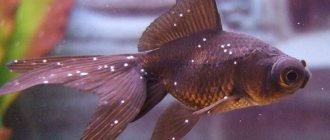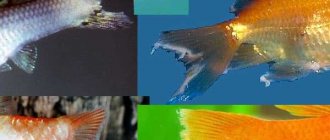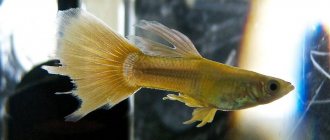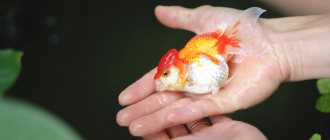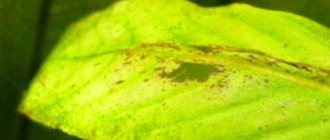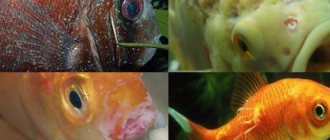Treating fish with salt is widely used today by many experienced aquarists. This therapy is safer and often gives the same effect as using pharmaceutical drugs. Salt is a publicly available product, so anyone can use salt baths in an aquarium. But in order for the treatment to bring results, it is important to understand how to carry it out correctly and how much salt to add to the water.
Indications for using salt
Salt baths have a wide spectrum of action. They have a positive effect on the health of both the individual inhabitants of the aquarium and its ecosystem as a whole. They should be used in the following cases:
- To eliminate the effects of stress in the body. Most often, it occurs when there is a sudden change in water parameters or living conditions (for example, as a result of transportation, quarantine, or nitrite poisoning);
- To improve the functioning of the cardiovascular system of fish (have a positive effect on blood flow);
- For the treatment and prevention of various diseases.
Diseases treated with salt baths
Salt often copes with many diseases no worse than drugs from the pharmacy. It can be safely used for the following diseases:
- Ichthyophthyriosis. The causative agents are parasites and ciliated ciliates. It is the appearance of small white spots on the body of fish.
- Saprolegniosis. This disease is caused by fungi. It is manifested by the appearance on the body of an individual of a white coating similar to mold. Next, ulcers, suppuration, bruising, rot and unsticking of the fins form. Treatment will be effective only in the early stages.
- Ichthyobodosis (or costiosis). Appears as a result of the activity of single-celled parasites. The fish's scales become dull and gray or dull blue spots appear. As the disease progresses, the entire skin becomes gray, the functioning of the respiratory system deteriorates and mucus secretion increases.
- Trichodinosis. Also caused by single-celled parasites. Infected individuals develop scabies and an increased need for oxygen. Matte areas form on the skin, and a plaque becomes visible, which is formed as a result of abundant mucus secretion. The gills turn pale.
- Fin rot. The causative agents of the disease are bacteria that enter the aquarium with soil, low-quality food, decorations, etc. In the early stages, the fins change color, later they begin to rot (first at the edges, and then completely) and fall off. During the course of the disease, first red stripes (caused by blockage of blood vessels) and then ulcers form on the body.
- Gyrodactylosis. Appears and progresses as a result of the activity of flatworms. It is manifested by increased scabies and the need for oxygen (the fish stays in the upper layers of water). Afterwards, gray areas form on the body, which then develop into ulcers. Some areas of tissue are destroyed and fall off.
Also, salt baths will be effective for the treatment of other diseases: branchiomycosis, hyosis, dactylogyrosis, diplozoonosis, sanguineosis, tetrachymenosis, oodiniumosis, chylodonellosis, plistophorosis, columnariasis.
It is important to remember that although salt is the least aggressive drug in comparison with pharmaceutical products, it does not need to be used in all cases. Sometimes it will be enough to change the water parameters (hardness, acidity, temperature, chemical composition) or check the serviceability of the devices (filter, aerator) to fix the problem. Only if these measures do not bring results, you can start using the baths.
Main symptoms
The symptoms of this disease are quite characteristic, so it can be easily identified. With this pathology you can notice:
- cloudiness of fins;
- the appearance of red spots and stripes is a consequence of blockage of blood vessels;
- change in the color of the fins, which become bluish (the color changes from the edges, gradually spreading over the entire surface);
- breaking off fins;
- the appearance of ulcers throughout the body - this occurs at the last stage of the disease, so the probability of death of the aquarium fish is very high.
Rules before baths
To ensure that salt not only does not cause harm, but also helps solve the problem, the following rules must be followed:
- Two days before using the saline solution, increase the temperature in the aquarium to 27-29°C;
- Carry out treatment only in settled water;
- The duration of the procedure should not exceed 20 minutes;
- Therapy must be carried out in a course, the duration of which is determined depending on the disease;
- Saline solution should not be used in tanks with high concentrations of nitrates - this will only make the problem worse.
How to treat fin rot in a betta?
To cure an aquarium fish, it is necessary to take into account the characteristics of a particular species. The scheme of further treatment depends on this. For example, consider a cockerel.
When the first symptoms appear in this fish, there is no need to immediately use medications. To begin with, you can disinfect plants, soil and decor. It is necessary to replace a third of all water, raise the temperature to the maximum permissible values (for this individual). Such conditions must be maintained for several days.
If this does not help, then you can use specialized tools. As a rule, they can be treated in a community aquarium, diluting the product in the dosage indicated on the package.
Instructions for salt baths
It is recommended to carry out therapy only in separate tanks (jigs), and not in a general aquarium. Thus, healthy fish will not be exposed to unnecessary effects of salt, and sick fish will experience only a short-term effect. It is important that the water temperature in the fish tank does not differ from the water temperature in the main aquarium by more than 2°C.
Instructions:
- The salt concentration in the healing pond should not exceed 3%. The optimal option would be 2% for diseases of moderate and minor severity. With experience in using salt baths, every aquarist comes to an understanding of what concentration is ideal. But for the first time, it is necessary to carefully observe the behavior of the fish in the bath. If the fish begins to float up, greedily swallow air, roll over, or a large amount of mucus appears on its body, then you need to stop the procedure immediately.
- A powerful filtration and aeration system must be installed in the sedimentation tank.
- To treat many parasitic diseases, it is enough to carry out the procedure for 15 minutes in a 1.5 - 2% salt solution. To disinfect an aquarium, a 5% concentration of this solution should be used. But it is important to remember that such an aggressive environment kills all living organisms, so before disinfection you need to completely clean the reservoir.
- Baths cannot be done every day. They should be used every other day or every two days. The duration of the course depends on the rate of recovery of the fish. On average, you will need from three to ten procedures.
- After treatment, fish should not be immediately placed in a common reservoir. It is necessary to gradually add new water to the tank, reducing the concentration of the saline solution. Or, to achieve a greater effect, you can transfer the animal to another body of water with a lower concentration (and so on 3-4 times).
Dropsy
If you notice that your betta fish has a swollen belly, treatment will be effective only at the very beginning of the disease. Dropsy is a very serious disease. There can be many reasons for the occurrence, it is important to find the source in time and promptly seek diagnostics from specialists. You can independently determine it by the following signs:
- Enlarged belly.
- Red spots at the base of the fins.
- Refusal to eat.
- Bruises on the body.
- Swollen eyes.
- Fast weight loss.
Important! In most cases, the source is a bacterial infection contracted while digging in the ground. Pay attention to the ammonia content in the water and inappropriate diet: as a result of unscrupulous care, the pet may die. If you notice a symptom such as constipation in your betta fish, treatment should be started immediately!
Keep in mind that in such a situation, complete disinfection and replacement of decorative elements, plants and other attributes are necessary.
Long salt baths
Long-term baths can also be used to treat these same diseases. Their duration can range from 2 days to 2 weeks. This therapy is excellent for viviparous species, cichlids, cyprinids and goldfish. In this case, salt should be added to the treatment tank at the rate of one teaspoon per liter of water . It is important to remember that such baths can only be carried out in bodies of water where there are no plants. Water changes should be carried out once a week, adding a solution of the same concentration to the aquarium.
Fish should not be kept in a salt aquarium for more than two weeks. Otherwise, individuals will experience kidney problems.
Saline solutions are also used to treat fish poisoning with nitrites.
Poisoning due to nitrites is more dangerous. In an aquarium, it is a product of the breakdown of ammonia, as it appears during the nitrogen cycle. A large amount of nitrites in water leads to damage to the respiratory organs and the appearance of processes that are incompatible with life.
Poisoning is indicated by the constant presence of fish near the surface of the water. They breathe quickly, their gills become dark, and convulsions occur. In the absence of urgent measures, aquarium inhabitants die.
To reduce the concentration of nitrites, salt is used, which should be added to water at a rate of 1 g/l, and a 1% solution of methylene blue in an amount of 3 mg/l of water. There will be no threat of departure if the water is constantly changed, the filter is cleaned, and uneaten food is removed from the bottom.
Contraindications for using salt solution
Unfortunately, not all types of fish tolerate salt baths well. Some of them cannot be found in such solutions at all. These include:
- Young labyrinth fish;
- Kalamoichty;
- Thoracatum;
- Corridors;
- Loricarids;
- Ancistrus;
- Pterygoplichts;
- Barbs.
Salt baths have already cured a huge number of fish. Their effect is truly amazing and unique. Compliance with all the rules and instructions will lead to easy treatment and quick healing of many diseases.
Description of ichthyophthyriosis
Having penetrated into a closed environment, the disease quickly spreads among all inhabitants of the aquarium. The pest cells primarily invade the epithelium, where they feed on the skin tissue. Internal damage to the body is necessarily reflected externally, and it is not difficult to notice these changes at curable stages.
The causative agent of the disease
The cause of semolina is ichthyophthirius (lat. Ichthyophthirius multifiliis). This is a ciliate with a size of only 0.5-1 mm and a round shape. On the outside, the parasite is covered with many cilia for movement, among them there is a microscopic mouth opening. Inside the cell there are two nuclei: a large horseshoe-shaped one and a small one, as well as contractile vacuoles and dark inclusions - the food of ciliates.
It is impossible to see the ciliate with the naked eye, so it easily penetrates into new water spaces, manages to take root and reproduce before more noticeable symptoms of its presence appear. During this time, fish semolina goes through several stages of development.
Life cycle of ichthyophthirius
Despite the fact that the pathogen is a protozoan, its life cycle is polymorphic and consists of four stages:
- The cell - theront - floats freely and finds its victim, where it penetrates under the scales, into the gills, the cornea of the eyes, and fins.
- The form becomes encysted and becomes overgrown with a protective shell. At this stage, the parasite actively feeds on tissues, developing over time into a trophont. Then external symptoms appear on the fish itself.
- Maturation of the cell - trophozoite - and release into the external environment. Adult ichthyophthirius settles to the bottom.
- The trophozoite secretes a cyst. Daughter cells are formed in it - from 500 to 1000 tomits, or “vagrants”, which over time go in search of the next source of food. Their sizes are 30-50 microns.
Symptoms
Symptoms of ichthyophthirius in the body appear from the first days of the presence of the parasite. Its development is manifested in a number of behavioral and external changes in the fish, which become more and more noticeable over time.
Behavior
2-3 days after the defeat, the fish becomes more restless. It constantly rubs against the surface, soil, vegetation. If there is aeration in the aquarium, the pet will increasingly swim towards the bubbles. This is how the fish reacts to the itching caused by ichthyophthirius under the epithelium or in the gill filaments.
Barbus in the aquarium. Gold fish. Bubbles. Swirl.
External signs
When the parasitic cells gain strength and grow, very noticeable convex white dots appear on the fish’s cover. If the owner misses the ichthik, then soon all the scales will be covered with “semolina”, the fins will begin to collapse, and the fish itself will stick to the surface and swallow air. The critical stage is characterized by large ulcers growing from spots and blindness. Fish in this state can hardly be cured - they die. This usually occurs after two weeks without action being taken.
Appetite
Any health problems affect the fish's appetite. Ichthyophthiriasis is no exception: at first the individual consumes much less than the usual norm, then completely refuses food. The exact cause of such changes can only be established in conjunction with other symptoms.
Causes
The causative agent of semolina in fish lives not only in aquariums, but also in ordinary fresh water bodies. In this regard, it can penetrate into a clean environment in two ways:
- Through live food, soil, plants that were taken from a reservoir and not treated with boiling water;
- With new individuals, mollusks, algae, as well as equipment that were previously in contact with an aquarium where the situation with ichthyophthyriasis is unfavorable;
Ciliates can end up in an aquarium at any time of the year, but most often in the spring-summer season. It is then that the protozoa reproduce in natural conditions.
Potential victims
Ich can be caught by any aquarium fish. Another question is that organisms cope with it differently. The most resistant species are all representatives of zebrafish, Siamese algae eaters, comets, shubunkins, goldfish, and low-finned guppies.
Owners of the following species should be most wary of the appearance of ichthyophthirius in the aquarium:
- Haratsinki;
- Barbs;
- Labyrinthine;
- Most catfish;
Important: often in goldfish, ichthic progresses completely differently, and instead of the usual semolina, redness appears on the body, as if due to an infection.
Ichthyophthirius also parasitizes masonry. Diseased eggs die on the third day. Viviparous fry that pick up ciliates in the mother's body die at the age of 5-7 days. Other inhabitants of the aquarium - snails, shrimp and the like - will never catch ichthyophthyriasis in fish.

